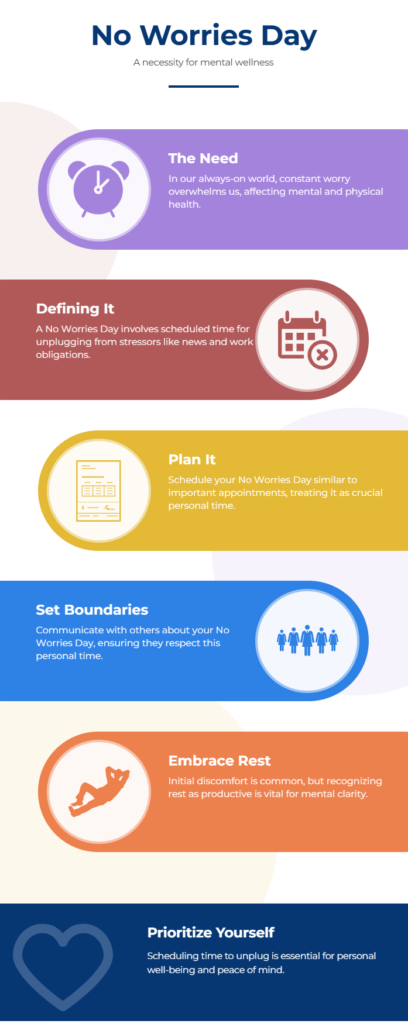Don’t miss a post. Click here to sign up for our free newsletter.
Estimated reading time: 6 minutes
No Worries Day
Have you ever caught yourself in a moment of stillness—no buzzing phone, no breaking news, no mental to-do list—and thought: Wait, something must be wrong? If so, you’re not alone.
We live in a world that’s always “on.” Between 24/7 news, social media scrolls, inbox overload, family responsibilities, workplace pressures, global crises, and the relentless march of personal and professional goals, it’s no wonder so many of us feel wired, tired, and perpetually on edge.
So what if we gave ourselves permission—actual, scheduled permission—to unplug from all that? Not just during a vacation or a mindfulness retreat, but right in the middle of our regular lives?
Let’s talk about the concept of a “No Worries Day.”
Not a vacation. Not a cheat day. Not a luxury.
But a necessity—and a radical act of self-preservation.
The State of Constant Worry
We don’t need to look far for things to worry about.
A Pew Research study found that seven in ten adults feel overwhelmed by the constant news cycle. Add to that economic uncertainty, political polarization, health scares, climate change, parenting challenges, and the unrealistic highlight reels of social media—and it’s a lot to carry.
The American Psychological Association (APA) reports that chronic worry and anxiety are on the rise, particularly among younger adults and women. Stress-related conditions like insomnia, burnout, and even autoimmune issues are becoming increasingly common.
To make things worse, our bodies don’t know the difference between an email from your boss at 9 p.m. and a bear chasing us in the woods. Stress is stress, and prolonged exposure to it without recovery leads to serious consequences: brain fog, mood swings, high blood pressure, and more.
“We’re not meant to be always-on. Even machines require downtime. Why wouldn’t we?”
Enter: “No Worries Day”
Imagine this:
- No alarms.
- No email.
- No news.
- No social media.
- No planning.
- No checking.
- No drama.
Just a few hours—or a full day—without engaging with what normally steals your peace.
This is your “No Worries Day”. A dedicated time to intentionally set aside the swirl of obligations, anxieties, and overthinking. Not to ignore them forever, but to hit pause, take a breath, and create space to just be.
And guess what? Science supports it.
The Research-Backed Power of Mental Off-Time
Neuroscience shows that the brain functions best with alternating periods of focus and rest. The Default Mode Network (DMN)—the part of the brain that kicks in when we daydream, rest, or reflect—is crucial for problem-solving, memory consolidation, and creativity.
When we never give ourselves breaks, we short-circuit this vital mental mechanism.
In fact, a study published in Cognitive, Affective & Behavioral Neuroscience found that intentional rest can improve emotional regulation and reduce cortisol, the stress hormone.
And here’s another eye-opener:
A 2023 study in Nature Mental Health showed that even brief, planned mental breaks (think: 30 minutes of device-free relaxation) reduce inflammation markers in the body. That means you’re not just feeling better—you’re literally healing when you rest.
How to Design Your “No Worries Day”
Now for the real question: How do we make this happen when life never stops demanding things from us?
Here’s a practical and flexible framework:
1. Plan It Like You Mean It
Just like you’d schedule a dentist appointment or client meeting, put your “No Worries Day” on the calendar. Treat it as non-negotiable time. Even if you can’t spare a full day, aim for a recurring half-day or evening.
“No one gives you the time—you have to take it.”
2. Define the Rules
This is your day to disconnect from anything that fuels anxiety or requires emotional labor:
- No checking email or news.
- No doomscrolling.
- No drama (even well-meaning drama from friends, family, or coworkers).
- No goal setting, project planning, or personal development.
- No multitasking.
Instead, try:
- A walk without your phone.
- Journaling just for fun.
- Reading fiction.
- Napping.
- Watching birds.
- Listening to music.
- Doing nothing—and not feeling guilty about it.
3. Put Devices Away
If you do nothing else, ditch your phone and screens for the duration. We know—easier said than done. But studies have shown that even having your phone in the same room reduces your cognitive performance. Out of sight, out of mind really works.
You’ll be amazed at how peaceful it feels when no one can reach you for a few hours—and how quickly you stop missing it.
4. Set Boundaries with Others
Tell your family or housemates what you’re doing and why. Set expectations ahead of time so they know not to bring you problems, gossip, or to-do lists during your “no worries” time.
Make it a family thing, even! Encourage your partner or kids to join you in their own way.
5. Embrace Stillness
This is the hardest part. Our culture glorifies productivity and equates rest with laziness. You may feel guilt or discomfort at first, like you’re wasting time.
But as author Alex Soojung-Kim Pang puts it in his book Rest: Why You Get More Done When You Work Less, rest is not the opposite of work—it’s part of it.
What You’ll Likely Notice
After your first few No Worries Days, you might start to observe:
- Clearer thinking
- Better sleep
- More emotional resilience
- A deeper sense of calm and contentment
- Reduced cravings for constant stimulation
- More appreciation for little moments
You may also find it easier to distinguish between real problems and imagined ones. What feels urgent in the heat of the moment often shrinks in importance when we step back.
“The things we worry about are often either out of our control, or completely imagined. Taking a break reminds us of that.”
Bonus: Bring It Into Your Everyday Life
You don’t have to wait for your next “No Worries Day” to reap the benefits.
Here’s how to bring some of that calm into your regular routine:
- Start your mornings with 5 minutes of stillness—before email or news.
- Take worry-free walks (no phone, no podcast, just you and the world).
- Set screen-free zones in your home.
- Establish drama boundaries—don’t let others’ chaos invade your peace.
- Create a “worry list” notebook: when anxious thoughts show up, jot them down and tell yourself, “I’ll revisit this later.”
Let’s Open the Conversation
Now, we’d love to hear from you:
- Have you ever tried a “No Worries Day” or something similar?
- What’s the hardest part of disconnecting?
- What helps you truly relax and let go?
Drop your thoughts in the comments—or better yet, invite someone you know to try this with you. Let’s make this concept a shared movement of mindful restoration.
Because in a world that constantly demands more, choosing peace is nothing short of revolutionary.
Your challenge
Try your own No Worries Day this week. Half a day counts. Leave your phone behind. Let go of goals. Give yourself space. Then tell us what you noticed.
You deserve that kind of care!
Check out The Seven Pillars of Sustainable Health and Wellness, an introduction to our overall wellness coaching strategy.
Subscribe to our free newsletter to receive more health tips right in your inbox, or schedule a free 30-minute 1:1 call for a personal consultation.
No Worries Day | Cheat Sheet

